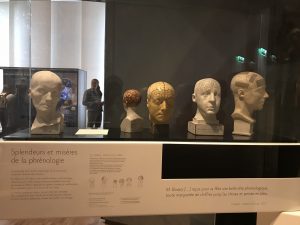Have you ever been told that you have a big or lumpy head? Well you might be in luck! Well, maybe, but most likely not…I’ll explain further. During our visit to the Musée de l’Homme, I got to learn about everything from Neanderthals to the history and science behind acupuncture. But there was one exhibit in particular that caught my eye (and this is where your lumpy head comes into play). About 200 years ago, Franz Josef Gall and Johann Gaspar Spurzheim promoted their research into the ‘science’ of phrenology. Phrenology is the study of skull morphology in relation to personality traits, and if that seems a little ridiculous it’s because it is. Gall and Spurzheim believed that the shape of your skull could determine twenty-four different ‘faculties’ that make up a person, which include things like ‘clingyness’ in relationships, destructive behavior, musical talent, metaphysical perspicuity, cautiousness, self-pride, acquisitiveness, verbal memory, disposition for color, number of sexual partners, and sense of direction. They travelled around Paris, lecturing to university students, and gained a small following. Unsuprisingly, the theory didn’t survive for very long as newer, more believable discoveries were made. However, using his knowledge of the human skull, Spurzheim himself made considerable contributions to neuroanatomy. He worked with Gall to publish books about the brain and central nervous system, but his open support of the infamous phrenology discredited him findings (Sanders et al., 2017).
Though the pseudoscience is just a thing of the past, not everyone is quick to dismiss it. Even though phrenology has been proven an empty theory, a group of researchers wanted to test if Spurzheim was on to something. Using the 23 faculties of phrenology, Jones et al. (2018) developed a list of comparable behaviors that would be measurable in people today and in 1815. They used MRI to measure brain curvature statistics and compare the lifestyle statistics of those individuals. Unfortunately, they found no correlation at all between brain curvature personality traits. Jones at al. (2018) were so confident in their findings that they claimed, ‘a more accurate phrenological bust should be left blank since no regions on the head correlate with any of the faculties that we tested.’ Though Gall and Spurzheim had a decent idea in mind, they cannot beat modern science, and since there was no evidence at all that they were on to something, phrenology can only be a distant memory. Phrenology was just another step (maybe in the wrong direction?) on the long path to understanding neuroscience.

Figure 1. Some heads of famous people (left to right): Franz List (musician), Johann Wolfgang von Goethe (playwright), Vito Mangiamele (math prodigy), Pierre François Lacenaire (thief and assassin), Apollon du Belvédère (Greek god Apollo), and Venus de Milo (Greek god Aphrodite).

Figure 2. The infamous phrenology faculty busts, including a bust of Franz Josef Gall on the far left, at Musée de l’Homme.
Works Cited
Jones, P. O., Alfaro-Almagro, F., & Jbabdi, S. (2018). An empirical, 21st century evaluation of phrenology. Cortex, 106, 26–35. https://doi.org/10.1016/j.cortex.2018.04.011
Sanders, F. H., Fisahn, C., Iwanaga, J., Oskouian, R. J., & Tubbs, R. S. (2017). Johann Gaspar Spurzheim (1775–1832) and his contributions to our understanding of neuroanatomy. Child’s Nervous System, 33(6), 877–879. https://doi.org/10.1007/s00381-016-3179-y
